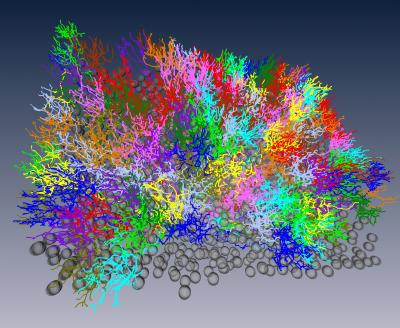New tools accelerate mapping the brain’s connectome
July 29, 2011

A reconstruction of 114 rod bipolar nerve cells from a piece of mouse retina. The dense bundles (top) are dendrites, and the sparser processes below are axons (credit: MPI for Medical Research)
New software tools to reconstruct neural wiring diagrams quickly and accurately have been developed by researchers at the Max Planck Institute for Medical Research to allow neuroscientists to understand the structure of the brain’s circuits — the connectome.
The researchers created two new computer programs, KNOSSOS (named for Crete’s legendary palace, renowned for its elaborate labyrinth) and RESCOP, and mapped a network of 114 neurons from a mouse retina faster and more accurately than with previous methods.

Dendrites form dense bundles where bipolar cells receive signals from rod photoreceptors (gray spheres) (credit: MPI for Medical Research)
The researchers started by staining the neurons of a section of tissue with heavy metals to make them visible. Using three-dimensional electron microscope images, they started at the cell body and followed the dendrites and axons, marking the branch point nodes on the screen. Then they used a computer to generate a three-dimensional image of the section.
The KNOSSOS software is about 50 times faster than other programs in tracing connections between neurons. The RESCOP program allows dozens of people to work on the reconstruction at the same time and allows for error detection and reduction.
With some 70 billion neurons, each neuron linked to about a thousand others via dendrites and axons, and hundreds of thousands of kilometers of circuits, the human brain is so complex that for many years, it seemed impossible to reconstruct the network in detail, the researchers said.
One person working alone with the currently available programs would take at least 30 years to reconstruct a path of just 30 centimeters in length, they estimate. Besides, these procedures are prone to error, since the branch points are not always easily recognized and the annotator’s attentiveness decreases with time.
Ref.: Moritz Helmstaedter, Kevin L Briggman, and Winfried Denk, High-accuracy neurite reconstruction for high-throughput neuroanatomy, Nature Neuroscience, 2011; 14 (8): 1081 [DOI: 10.1038/nn.2868]
